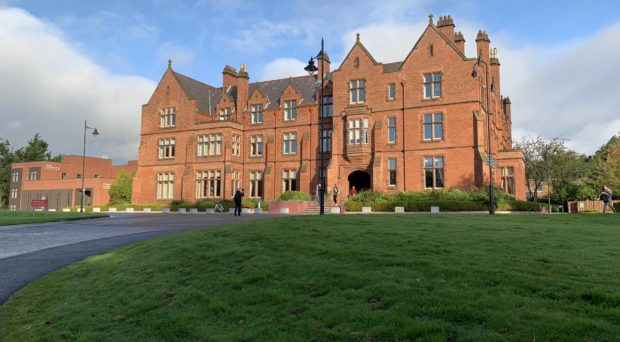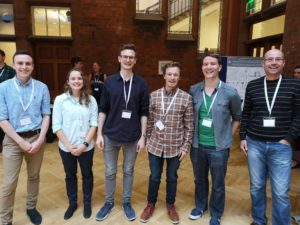
First of all, thanks to Dr. Paul McVeigh for bringing together a stimulating set of speakers from across Europe and North America, to participate in the British Society for Parasitology Autumn Symposium on ‘Post-genomic progress in helminth parasitology’.
The meeting was held at Riddel Hall, a Grade-2 listed red-brick building, established in 1913 as a Queens University hall of residence for women. This was made possible by the hard work of Irish feminists which lead to courses and degrees in all Irish universities being made open to women in 1908.
The symposium was composed of 9 speakers giving thirty minute seminars to the ~80 attendees, and hopefully this blog will give those unfortunate enough not to be one of them a chance to catch up on the proceedings.
Identifying anti-parasitic targets
Following a cream tea breakfast, the meeting was opened by Dr. Angela Mousley (QUB), who spoke on the investigatory nature of her work examining the effects that neuropeptides have on the development of nematodes, and using this to establish novel drug targets for the treatment of Ascaris (roundworm) infections.
Later in the day, Professor Aaron Maule (QUB) also presented peptide based research, this time with Fasciola. He showed how the coordination of fluke proliferative cells drives parasite growth and may offer avenues for future combination therapies using anthelmintic drugs and stem cell regulators.
Dr. Collette Britton (University of Glasgow) presented Glasgow’s research on utilising big genome data on small RNAs, with particular emphasis on the information obtained on microRNAs of nematodes (including parasitic Haemonchus contortus, Brugia pahangi, and the free-living nematode Caenorhabditis elegans). The microRNAs in question are involved in the crucial L3 to L4 larval development pathways in these nematodes, and therefore suggest new developmental stages that inhibitors can be designed for and then applied in new therapeutics for parasite control.
Searching for drug resistance in the modern age
Professor John Gilleard, making the long trip from the University of Calgary, Canada (sponsored by Irish Society for Parasitology), shared his lab’s work on tracking back the origins of Benzimidazole drug resistance in the ‘poster child for anthelmintic resistance’, Haemonchus contortus (a seriously pathogenic nematode of ruminants). They did this by following resistance mutation frequencies using genomic and transcriptomic strategies in worms collected from Canada, USA, India, UK, and Pakistan. John warned how anthelmintic drug resistance is a general outcome of selection pressures, and highlighted how this can differ depending on the region and farming practices in question (read related publications here).
Moving from nematodes to trematodes, the resistance theme continued with Professor Jane Hodgkinson (University of Liverpool) presenting the developing results to statistically differentiate triclabendazole exposed and non-exposed Fasciola hepatica populations on UK farms, using genome SNP data, metabolite analysis and excellent experimental design.
CRISP(R)s and other titbits
After delegates had executed typical refreshment seeking behaviour during a short coffee break including more scones, jam and cream (in that order one should add), Professor Elissa Hallem (UCLA) shared her groups work on host seeking behaviour of skin penetrating nematodes, namely Stongyloides stercoralis. Chemotaxis and thermotaxis of S. stercoralis was investigated in a classical manner using thermal and chemical gradients, but more recently using CRISPR-Cas9 techniques. This helped to establish many factors involved, including the heat seeking AFD neurons in the worm’s head. From an evolutionary standpoint, these multisensory mechanisms seem critical in the persisting success of these worms.
Further CRISP-Cas9 success was presented by Professor Paul Brindley (George Washington University) who’s lab use this technique to target omega-1 of Schistosoma mansoni, a secreted ribonuclease crucial in egg granuloma formation, the causative factor for some of the more serious morbidity seen in intestinal schistosomiasis.

Elsevier Poster prizes
Lunch was served in the old courtyard of Riddel Hall, fortunately now covered with a glass roof to shelter the posters being presented from the Belfast drizzle. Nineteen posters were being presented on several aspects of molecular helminthology. Poster prize awards were announced later during the evening reception congratulations to students: Duncan Wells, Jennifer Noonan, Nicolas Feldman, and Postdocs: Dr Paul Airs, Dr Paul McCusker and Dr Oliver Weth (affiliations and poster titles can be viewed here).
Friend-zone: relationship statuses of parasites
In the final session, we were transported virtually to the attic of Professor Mark Blaxter (Wellcome Sanger Institute), who following flight cancellations gave a virtual presentation (with thankfully, very few technical glitches!). Mark has recently joined the exciting ‘Darwin Tree of Life’ project. Among the 60,000 eukaryotic species from the UK that will have its genetic code mapped, roughly 30% will be parasites! Data was presented concerning the 2-for-1 issue of sequencing filarial nematodes, in that the symbiotic bacteria Wolbachia also sequenced with the worm needs to be quickly (due to scale of this project!) and accurately removed from parasite genomes. Good luck Mark et al…!
To finish of the day, Professor Christoph Grevelding (Justus-Liebig-Universitat Giessen) gave delegates a peek through the ‘omics keyhole regarding the complicated love story of schistosomes (flatworms with male and female organisms, known as dioecy), which has driven long-term research goals in Christoph’s lab. Such complexities relate to the large sexual dimorphisms that occur during development; males being the same if ‘single’ or ‘paired’, whereas females change dramatically. This requires next generation tools to offer insight into the neuropeptides and GPCRs dictating these relationship status changes.
The next BSP meeting will be held in Spring 2020 in Edinburgh. Thanks again to delegates attending the Autumn Symposium in Belfast, and to the sponsors for their support.

Comments